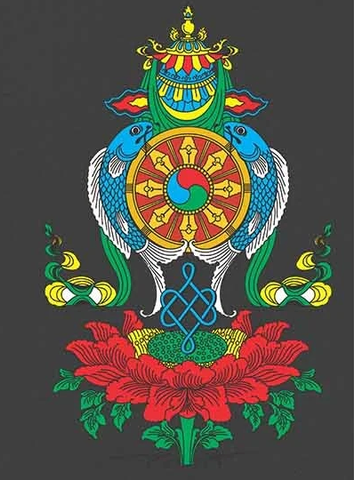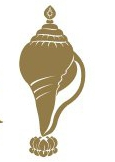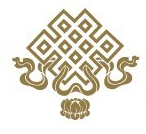
The Ashtamangala (ashta meaning eight and mangala meaning auspicious; Sanskrit Aamagala) is a collection of eight auspicious symbols venerated in Hinduism, Jainism, Sikhism, and Buddhism for its sanctity. Originally employed in India at kingly coronations and rituals, they've since been ingrained in a variety of civilizations, and are frequently found as popular themes in homes and art.
Yidam and teaching tools are the symbols or "symbolic characteristics." These characteristics, these energetic signatures, not only hint to enlightened mindstream qualities, but they are also the adornment that adorns these enlightened "qualities." There are several cultural enumerations and variants of the Ashtamangala.
In India, groups of eight auspicious symbols were first employed during rituals such as a king's investiture or coronation. Throne, swastika, handprint, hooked knot, vase of jewels, water libation flask, pair of fishes, and lidded bowl were among the early emblems. These eight emblems of good fortune in Buddhism symbolize the gods' presents to Shakyamuni Buddha shortly after he attained enlightenment.
Symbolism and Meaning of Ashtamangala

The Ashtamangala were originally counted as a throne, a swastika, a handprint, a knot, a treasure urn, a ewer, a pair of fish, and a covered bowl in Buddhism, but since the twenty-first century, the following eight have become the most commonly utilized and worshipped.
They frequently take on the simulacra shape of a vase when shown as a composite group. The treasure vase may be removed in this form since the other seven symbols, with their vase-shaped contour, encapsulate the vase's metaphorical riches.
Designs of these eight symbols of good fortune may be seen on carved wooden furniture, decorated metalwork, pottery, wall panels, and silk brocades, among other holy and secular Buddhist artifacts.
To welcome visiting religious dignitaries to monastic monasteries, they are also painted on the ground with scattered flour or colored powders.
1. Conch Shell

White Conch Shell signifies the all-pervasive voice of dharma, and it is believed to rouse individuals from a profound slumber of ignorance, encouraging us to seek our own and others' well-being. It is the hero's trumpet in Indian epic literature, and it represents the voice of Buddha and his sacred teachings in Buddhism. The conch shell is a Hindu emblem for the Sudarshana Chakra.
What are the many Hindu depictions of the conch shell?
Vishnu's fire-emanating conch was termed Panchajanya, which means "controlling the five kinds of creatures."
Arjuna's conch was known as Devadatta, which means "God-given," and its victorious blow terrified the enemies.
As a war trumpet, the conch is similar to the modern bugle in its function as a symbol of power, authority, and sovereignty. Its auspicious blast is thought to drive away evil spirits, avoid natural calamities, and scare away dangerous creatures.
Vishnu holds the flaming conch in his upper left hand, which is linked with the wheel or chakra in his upper right hand.
These two characteristics are shared by the first five of Vishnu's 10 avatars or incarnations:
Matsya is a Fish. Kurma is a tortoise, Varaha is a hog, Narasingha is a man-lion, and Vamana is a dwarf.
What is the Buddhist symbolism of conch shells?
It was also embraced as an emblem of the supremacy of the Buddha's teachings by the early Buddhists. Conch represents his courage in declaring the truth of the dharma, as well as his appeal to awaken and strive for the sake of others.
His loud and booming conch-like voice, which resounds across the ten directions of space, is one of the thirty-two main indications of the Buddha's body. This sign is represented by three conch-like curving lines on his throat.
2. Kumbha-Treasure Vase

This vase symbolizes worldly comfort or fortune, as well as health and longevity, as well as spiritual advantages. It depicts the Buddha's neck and his limitless ability to teach the dharma, which never diminishes or loses its worth over time in Buddhism. It is the container of wisdom in Vajrayna anointing rites and can symbolise the immensity of space.
Treasure Vase Origin - Indian TraditionThe vase is inspired by traditional Indian clay water pots. With a flat base, circular body, thin neck, and fluted top rim, this pot is known as a kalasha or Kumbha.
This womb-like holy Kumbha is revered in India at the Kumbh Mela, the world's largest religious "pot festival." Every three years, this festival is observed in the towns of Allahabad, Haridwar, Nasik, and Ujain to commemorate the pouring of the heavenly nectar of the gods (Skt. amrita) at these four sacred locations.
Buddhism's Treasure Vase
The treasure vase is primarily associated with riches deities such as Jambhala, Vaishravana, and Vasudhara, where it frequently appears as an attribute beneath their feet.
Vasudhara, in one of her forms, stands atop a pair of horizontal treasure jars that drip an unending stream of diamonds. As the heavenly 'vase of abundance,' it has the property of spontaneous manifestation because no matter how much wealth is taken from it, it stays continuously filled.
3. The Jewelled Parasol

Parasol is called chatra is Sanskrit and atapatra in Tibetan. The jewelled parasol was originally an attribute of royalty in India, and in Buddhism, it portrays the Buddha's head, giving protection from material and spiritual hazards such as illnesses, destructive forces, and aetheric elements. It can also represent the canopy of heaven, the breadth of the firmament of the sky, and the spreading of space.
What does parasol symbolize in Ashtamangala?
The person or symbol beneath the parasol, according to Buddhist teachings, is the center of the universe. Several visual representations of Lord Buddha with a parasol over his head may be seen.
Because the parasol is held above the head, it naturally represents honor and respect, which is why it became such a popular iconic symbol in early Buddhist art.
4. The Endless Knot

The Endless Knot was once used as a love symbol, and it now represents the ultimate oneness of all things. The endless knot also symbolizes the Buddha's immense energy, the interconnection of all things, and the enlightenment that comes from combining compassion and wisdom.
Representation of Endless knot
The nandyavarta or swastika on the Buddha's breast is often shown as a symbol of his enlightened mind in Indian and Chinese representations.
Another possible origin for both the endless knot and the swastika is the S-shaped markings on the cobra's hood. As a consequence, the naga yantra, which comprises of two or more entangled snakes producing an endless knot design or yantra, was formed.
Because these parallel symbols were common to most early Indian traditions of the ashtamangala, the eternal knot or 'happy diagram,' which is defined as 'spinning like a swastika,' was connected with the shrivatsa-svastika in its final evolution as a geometric Buddhist sign.
5. Pair of Gold Fish

The two goldfish originally represented two sacred rivers in India, the Ganges and the Yamuna, and are linked to the moon and solar channels, which are said to begin in the nostrils and carry alternating breath and prana cycles. They mirror the Buddha's vision in Buddhism, as well as aiding individuals on the spiritual path to escape from samsara.
What do the two fishes represent in Indian culture?
This refers to their history as an ancient emblem of India's two sacred rivers, the Ganga and the Yamuna.
The moon and solar channels, or psychic nerves, which begin in the nostrils and convey the alternating rhythms of breath or prana, are symbolically represented by these two enormous rivers.
What do the two fishes represent in Buddhism?
Golden fishes are said to symbolise pleasure and spontaneity in Buddhism since they enjoy total freedom of movement in the water.
Because they multiply so quickly, they signify fertility and abundance. As they interact and touch freely, they symbolise liberation from caste and rank constraints.
6. Lotus
 Because of its capacity to float above murky water, devoid of attachments and wants, the Lotus Flower represents heavenly beauty and primordial purity. Buddhas and Bodhisattvas are frequently shown on lotus blossoms, which signify heavenly language and the cleansing of the body, mind, and spirit. The lotus flower is most commonly associated with the opening of our energy centers, or chakras. The lotus flower is known in Sanskrit as Padma or Kamala, and in Tibetan as chuckles. It is one of Buddhism's auspicious symbols.
Because of its capacity to float above murky water, devoid of attachments and wants, the Lotus Flower represents heavenly beauty and primordial purity. Buddhas and Bodhisattvas are frequently shown on lotus blossoms, which signify heavenly language and the cleansing of the body, mind, and spirit. The lotus flower is most commonly associated with the opening of our energy centers, or chakras. The lotus flower is known in Sanskrit as Padma or Kamala, and in Tibetan as chuckles. It is one of Buddhism's auspicious symbols.The Lotus Flowers' Importance in Hinduism
Surya, the Vedic sun deity, similarly holds a lotus in each palm, signifying the sun's journey across the skies. Brahma, the Vedic deity of creation, was conceived from a golden lotus that sprang from Vishnu's navel like an umbilical stem.
Padmasambhava – The Lotus-Born Padmasambhava – The Lotus-Born Pad
Padmasambhava, the tantric teacher who brought Buddhism to Tibet, was miraculously created from a miracle lotus that bloomed on Dhanakosha Lake in the western Indian kingdom of Uddiyana.
In both Hindu and Buddhist Tantra, the lotus is a powerful sexual metaphor as a celestial womb or vagina. Padma and Kamala are Sanskrit names for the soft, pink, and open ‘lotus' of the female vaginal canal.
Lord of Lotus Family-Amitabha
Lord Amitabha, the red Buddha of the west and the "Lord of the Padma or Lotus Family," is represented by the lotus.
Amitabha's qualities include the redness of fire, vital fluids, evening twilight, the summer season, and the transformation of desire into discerning wisdom.
Pandara, Amitabha's consort, is likewise endowed with a red lotus. Amitabha's presiding Bodhisattva is Padmapani Avalokiteshvara, the 'Holder of the Lotus' and the Bodhisattva of Great Compassion.
7.The Victory Banner-Dhvaja in Sanskrit

The Victory Banner depicts the Buddha's body and his victory over the four maras, or obstacles to enlightenment... pride, desire, unpleasant emotions, and fear of death. There are eleven distinct versions of the flag in Tibetan Buddhism, each representing a different means of battling evil energies.
What does Dhvaja mean in Sanskrit?
The dhvaja, which means banner, flag, or ensign in Sanskrit, was originally a military standard used in ancient Indian combat. This flag was mounted behind the big parasol or royal parasol on the back of a great warrior's chariot. Each flag was emblazoned with the emblem of its champion or king.
What exactly is the connection between Hinduism and the Victory Banner?
A garuda-topped flag decorated Krishna's chariot.
Arjuna wore a monkey's gadget.
Bhisma's was emblazoned with a palm tree.
The dhvaja was principally Shiva's ensign, the mighty deity of death and devastation, whose flag was capped with a trident. This trident represented Shiva's triumph over the three worlds, or "three cities," which were located above, on, and under the earth.
The Hindu Gods have praised Buddha.
Similarly, the gods opted to place a victory flag on the summit of Mt Meru to commemorate the Buddha's triumph against Mara's army.
A jeweled pole, a crescent moon and sun finial, and a hanging triple banderole of three multi-colored silks decorated with the "three victorious creatures of harmony" complete this "victorious flag of the ten directions."
8. Dharma-Chakra, The Wheel of Law

In Sanskrit, the Wheel is known as Chakra, while in Tibetan, it is known as khor-lo. The wheel is a solar sign of sovereignty, protection, and creation used by early Indians. The Dharmachakra, or "Wheel of the Law," is the most well-known emblem in Buddhism, traditionally signifying a Chakravartin, a moon or solar chariot drawn by royalty. A Chakravartin is a master of both land and sea, or physical reality and akashic waters, since his wheels spin without barriers.
What is the connection between Hinduism and the wheel?
The wheel, or chakra, is the primary attribute of Vishnu, the Vedic deity of preservation, whose flaming six-spoked Sudarshana-chakra or discus symbolizes the entire universe's wheel.
The wheel, like the rotating orb of the sky, signifies motion, continuity, and change, constantly turning onwards.
The Dharmachakra and Buddhism
The wheel was chosen as the principal emblem of Buddhism's "wheel-turning" chakravartin or "universal monarchy," with the wheel being identified as the dharmachakra or "wheel of dharma" of the Buddha's teachings. Dharmachakra literally means "wheel of transformation" or "spiritual change" in Tibetan.
You can read more on the Dharmachakra and its significance in our another blog here.
To find our Ashtamangala printed Products follow through this link.
You can also place your order for custom designed T-shirts, mugs, stickers, phone cases and canvases.
